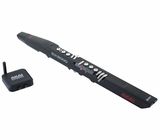I bought this instrument mainly to use in silent practice when I am away from home. This has changed recently because I now have studio monitors (KRK Rockit 5's from Thomann) which I'm using to amplify it and also play backing tracks on it simultaneously.
But, it will still have it's uses for silent practice. There are some differences in the fingerings between the EWI and the sax, even though it can be set up to play as a sax, you still need to get your head around certain differences, but this is fairly intuitive.
The other difference is that there's no need for a strong embouchure for higher notes, as you just roll your thumb up the octave rollers at the back to span 7 octaves effortlessly (compared to the sax's 2.5 octaves, which can be tricky to play at either end.
The issue I have is with the various sounds. They are not very authentic for some of the woodwind "programs" and (ironically) the saxophones are the least authentic of all, to my ears. But it you treat it like a completely different instrument, it's fine.
The program editor that comes supplied (or at least by download) is an essential tool in helping to tweak the various in-built sounds, but it takes some getting used to. I bought pre-sets for all 100 sounds from an expert in the USA and used his settings which really do seem to have made a difference to the onboard sounds.
The main advantage of this model over the less expensive EWI4000 is that it can be wireless. This is a major plus for anyone using it on stage or in a performance stetting (as the EWI does not have to be tethered to the amplifier (the wifi box is attached to the speakers.)
Even just using it at home, I have found the freedom I get from not being attached to the speaking with the USB cable a real bonus as I can have my music stand at the opposite end of the room from the speakers.
Overall, it's a fascinating instrument that will take a lot of time to use properly, but one that I am very glad to have bought.


